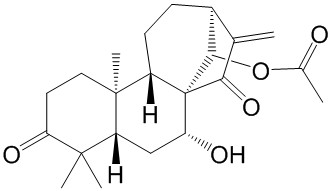Home
Products
Glaucocalyxin B



| Product Name | Glaucocalyxin B |
| Price: | $219 / 10mg |
| Catalog No.: | CN08240 |
| CAS No.: | 80508-81-2 |
| Molecular Formula: | C22H30O5 |
| Molecular Weight: | 374.47 g/mol |
| Purity: | >=98% |
| Type of Compound: | Diterpenoids |
| Physical Desc.: | Powder |
| Source: | The herbs of Rabdosia rubescens. |
| Solvent: | Chloroform, Dichloromethane, Ethyl Acetate, DMSO, Acetone, etc. |
| SMILES: | CC(=O)O[C@@H]1[C@H]2CC[C@@H]3[C@]1([C@H](O)C[C@H]1[C@@]3(C)CCC(=O)C1(C)C)C(=O)C2=C |
| Contact us | |
|---|---|
| First Name: | |
| Last Name: | |
| E-mail: | |
| Question: | |
| Description | Glaucocalyxin B is an ent kaurane diterpenoid isolated from the Chinese traditional medicine Rabdosia japonica with anticancer and antitumor activity; decreases the growth of HL-60 cells with an IC50 of approximately 5.86 μM at 24 h. |
| Target | IC50: 5.86 μM (HL-60 cell Growth)[1] |
| In Vitro | Glaucocalyxin A (GlnA) and (GlnB) dose-dependently decrease the growth of HL-60 cells with an IC50 of approximately 6.15 and 5.86 µM at 24 h, respectively. Both Gln A and B could induce apoptosis, G2/M-phase cycle arrest, DNA damage and the accumulation of reactive oxygen species (ROS) in HL-60 cells[1]. GlnB inhibits the proliferation of human cervical cancer cells in vitro through the induction of apoptosis andautophagy, which may be mediated by the phosphatidylinositol 4,5 bisphosphate 3 kinase/Akt signaling pathway. Treatment with GlnB inhibits the proliferation of HeLa and SiHa cervical cancer cell lines in a dose dependent manner. GlnB increases the apoptotic cell population of and enhanced poly (ADP ribose) polymerase 1 cleavage. GlnB also induces increased light chain 3 II/I protein cleavage, indicating the induction of autophagy. GlnB treatment increases the expression of phosphatase and tensin homolog and decreases the expression of phosphorylated protein kinase B[2]. Glaucocalyxin B (GLB), one of five ent-kauranoid diterpenoids, significantly decreased the generation of nitric oxide (NO), tumor necrosis factor (TNF)-α, interleukin (IL)-1β, cyclooxygenase (COX)-2 and inducible nitric oxide synthase (iNOS) in the lipopolysaccharide (LPS)-activated microglia cells[3]. |
| Cell Assay | The microglia cells viability is assessed by MTT assay. Cells are seeded in 96-well plates at the density of 5 × 104 cells/well. The cell culture supernatant is discarded after treatment with various agents, and then 30 μL of MTT (0.5 mg/mL) solution is added into each well. After incubation for 4 h at 37 °C, 100 μL of DMSO is added into each well to dissolve the formazan dye, and then the absorbance of solubilized formazan is measured by microplate reader[3]. |
| Density | 1.2±0.1 g/cm3 |
| Boiling Point | 509.1±50.0 °C at 760 mmHg |
| Flash Point | 172.9±23.6 °C |
| Exact Mass | 374.209320 |
| PSA | 80.67000 |
| LogP | 1.37 |
| Vapour Pressure | 0.0±3.0 mmHg at 25°C |
| Storage condition | 2-8°C |